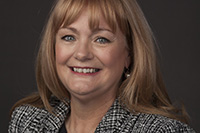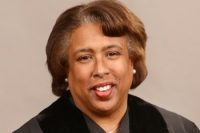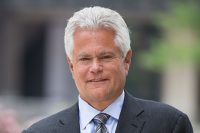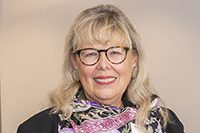
A practicing mediator since 1994, Sandra Crawford (’89) has dedicated her career to providing clients the best alternative paths to resolution. Venturing out as a solo practitioner that same year and adding family law to her real estate practice, Ms. Crawford recognized the opportunities family law presented, particularly in dispute resolution. In 2001, she became one of the first attorneys in Illinois to be trained in the collaborative law model. By the mid-2000s, she had shifted her primary focus to dispute resolution services in family law matters. Recently honored with a 2019 Distinguished Service Award for her accomplishments, we were happy to connect with Ms. Crawford again.
JMLS: Where were you born and where did you grow up? What brought you to Chicago?
Crawford: I was born in Dublin, Ireland, and lived there until I was 15 years old. My parents immigrated to Chicago to give my older sister, my two younger brothers, and me better educational opportunities. My father, who was the youngest of a large family, had older sisters and a brother who had live in Illinois since the 1960s, and they had encouraged him to come to “Chicargo” (yes, I spelled it with an “r” for the first several weeks after we arrived) for many years. When the economy took a downturn, my parents, who were both 40, decided to come to the U.S., sight unseen. When I turned 40, I came to understand how brave they had been and what they had sacrificed so their family could have a better future.
JMLS: How would you describe your experience as a student at John Marshall?
Crawford: I entered John Marshall in January 1985 as an evening student. At that time (as I said in my speech at the Freedom Awards), John Marshall was the place where working kids went after work. The vast majority of my friends and colleagues at John Marshall held full-time jobs while attending night school. There were many police officers, teachers, paralegals, and others. We even had a banker and a pharmacist in our section. My experience was richer for the perspectives and real-world experiences these classmates brought to the learning experience.
JMLS: What was your favorite class at John Marshall?
Crawford: Civil Procedure with Dean Gil Johnston. At one point during the term, I went to see Professor Johnston. I was gripped by the fact that in my mind I saw CivPro as a roadmap of interconnected parts. As I was enthusiastically describing to him what I thought was a novel way to think about CivPro, he quietly reached behind his credenza and pulled out a big map that he gave to me. It mapped out CivPro in detail… Sadly, I don’t remember what I did with it.
JMLS: How did you get into the practice area of family law and mediation?
Crawford: While I was at John Marshall, I was a client in a mediation process and fell in love with the dispute resolution model. In 1993, I went through the 40-hour Mediator Training Program at the Center for Conflict Resolution in Chicago (CCR), and then I volunteered twice a month for almost three years with CCR and mediated in many venues around Cook County, including landlord/tenant court, the Department of Human Rights, and small claims court. Application of the mediation model in separation/divorce matters couples is now well known, but at the time, in the 1990s, awareness was still growing.
In 1994, I started my solo general practice, and in addition to mechanic lien foreclosure litigation and real estate law (which I had done since 1990), I started practicing family law. I began moving my practice into that area exclusively by the early 2000s. In 2002, I trained in the collaborative law model of dispute resolution, which is a mediation-skills-based model of limited-scope representation. Through the early 2000s, I did a lot of real estate work, in addition to family law, but after the mortgage foreclosure crisis and downturn in the economy in the mid-2000s, those practice areas were no longer viable for a solo practitioner. Thereafter, I concentrated my practice in family law, preferring to offer mediation, collaborative process, and limited-scope representation services as those avenues result in more sustainable and cost-effective outcomes for families. I still do some family law litigation, but my heart is in alternative dispute resolution (ADR).
JMLS: Why do you think it is important to stay connected to your alma mater?
Crawford: I believe it is important, because it allows you to give back and help the next generation of lawyers, as well as helps you build connections and your professional reputation. I will admit that for the first 15 years after I graduated I was not connected. I was busy raising my twin daughters and starting my firm. After my children were out of college, I had more time and slowly started to reconnect with people I who had attended John Marshall. The internet has also really helped me to reconnect. Being connected has provided me with many opportunities to speak and serve as a guest lecturer in my areas of concentration—ADR and family law—which have made me a more confident presenter. Serving on the Alumni Board has introduced me to many more senior lawyers, as well as younger lawyers. This has expanded my circle of friends and colleagues, and it has expanded my referral sources, too. Staying connected just makes sense from a professional development and social perspective.
JMLS: What do you enjoy most about being an attorney?
Crawford: Helping people out of conflict and into more peaceful co-existence.
JMLS: What advice would you give to law students looking to enter family law or mediation?
Crawford: Get some grounding in psychology and sociology and practice good self-care.
JMLS: Will you share with us some of your hobbies or leisure activities?
Crawford: As one of my colleagues says, my hobby is “being a bar junkie.” My hobbies and leisure activities are most often related to my service to the Illinois Bar Foundation, the Illinois Bar Association, and the various local and international organization for the collaborative practice community.



